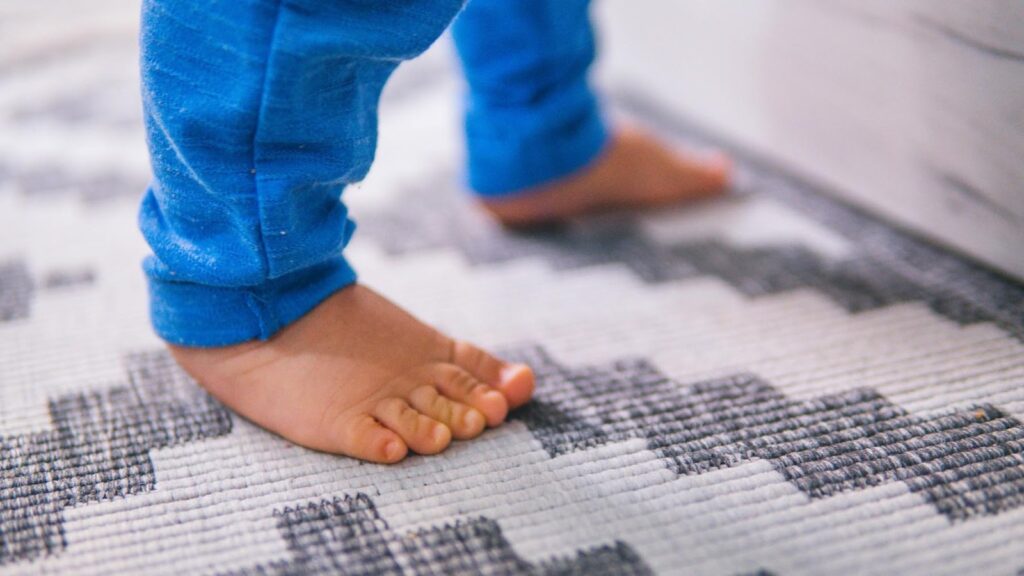How to Treat and Prevent Tip-Toe Walking in Toddlers
As a parent, watching your toddler take their first steps and explore the world around them is an exciting milestone. However, you may have noticed that your little one has a tendency to walk on their tip-toes, which can raise questions and concerns about their development.
Don’t worry, though! Tip-toe walking is a common occurrence in many toddlers, and as a friendly pediatric physical therapist, I’m here to guide you through understanding, treating, and preventing this behavior.
Why is This Important?
Tip-toe walking, medically known as “equinus gait,” occurs when a child walks on their toes without making contact with the ground with their heels. While it’s not uncommon for toddlers to engage in tip-toe walking occasionally, persistent toe-walking beyond the age of 3 or 4 can be a cause for further evaluation. Addressing tip-toe walking is important for several reasons:
Muscle Development: Walking on tiptoes regularly can impact the proper development of calf muscles, Achilles tendon, and other lower leg muscles, potentially leading to muscle imbalances.
Balance and Coordination: Walking with flat feet allows for better balance and coordination. Tip-toe walking might affect a toddler’s stability and overall motor skills.
Gait Abnormalities: Prolonged tip-toe walking can lead to gait abnormalities and postural issues if not addressed promptly.
Underlying Conditions: In some cases, consistent toe-walking could be an early indicator of an underlying neurological or developmental condition that may require intervention.
To ensure your child’s optimal growth and development, here are some friendly tips and tricks to help you treat and prevent tip-toe walking:
Tips and Tricks
Regular Footwear Assessment: Ensure that your toddler’s footwear is appropriate and comfortable. Shoes with proper arch support can encourage healthy foot positioning during walking.
Encourage Barefoot Play: Allow your child to spend some time walking and playing barefoot. This helps in strengthening the muscles of the feet and promoting a more natural gait.
Stretching Exercises: Gentle stretching exercises for the calf muscles can help maintain flexibility and prevent them from becoming overly tight.
Key Positions to Help
Encouraging various positions can aid in muscle development and overall motor skills:
Squatting: Regular squatting engages muscles in the lower body and encourages proper weight-bearing on the feet.
Kneeling: Kneeling activities enhance hip and knee joint flexibility, contributing to a well- rounded gait.
One-Leg Stance: Balancing on one leg, even briefly, strengthens the muscles needed for stability during walking.
Heel-to-Toe Rocking: Gently rocking from heels to toes promotes a full range of motion in the feet and ankles.
Exercises to Promote Healthy Walking
Engage your toddler in these fun exercises to support their walking development:
Calf Stretches: Gently press your child’s foot towards their shin, holding for a few seconds.
Toe Raises: Have your child practice lifting their toes while keeping their heels on the ground.
Marching in Place: Encourage marching while lifting knees high to strengthen leg muscles.
Obstacle Course: Set up a mini obstacle course to challenge balance and coordination.
Animal Walks: Mimic animal movements like bear crawls, duck waddles, and frog jumps.
Balancing Act: Have your toddler balance on one leg while reaching for a toy.
Stretchy Band Fun: Use a soft stretchy band for resistance exercises like pulling legs apart gently.
Line Walking: Encourage walking along straight lines on the floor to focus on heel-to-toe positioning.
Bubble Chase: Blow bubbles and encourage your toddler to pop them while walking.
Frequently Asked Questions
Q1: Is tip-toe walking always a cause for concern? Tip-toe walking is common in toddlers and often improves with time. However, if it persists beyond a certain age or is accompanied by other developmental delays, it’s a good idea to consult a pediatrician or physical therapist.
Q2: Could my child’s footwear be contributing to tip-toe walking? Yes, ill-fitting shoes or those with inadequate arch support can influence walking patterns. Opt for shoes that provide proper support and allow for natural foot movement.
Q3: Are there any red flags for an underlying condition? If your child consistently tip-toe walks beyond the age of 3 or 4, experiences discomfort, or shows other delays in motor skills, consulting a healthcare professional is recommended.
Q4: Can I do these exercises at home without professional guidance? The exercises mentioned are generally safe and beneficial. However, if you’re concerned or your child has a preexisting condition, consulting a pediatric physical therapist can provide tailored guidance.
Q5: My child only tip-toe walks occasionally. Should I still be concerned? Occasional tip-toe walking is usually not a cause for concern, especially during play. It’s the persistent and regular tip-toe walking that may warrant attention.
Q6: Are there any activities to avoid? Avoid forcing your child into flat-footed walking abruptly. Instead, focus on activities that promote balanced muscle development and coordination.
Q7: Will my child eventually outgrow tip-toe walking? Many children naturally outgrow tip- toe walking as they continue to develop and their muscles mature. However, paying attention to their development is essential.
Q8: Can I encourage my child to walk differently during play? Absolutely! Engage your child in activities that promote flat-footed walking, but remember that it’s a gradual process. Be patient and encouraging.
Q9: Could tip-toe walking lead to long-term issues? In some cases, persistent tip-toe walking could contribute to muscle imbalances and gait issues. Addressing it early can help prevent potential long-term problems.
Q10: When should I seek professional help? If your child’s tip-toe walking is consistent after the age of 3 or 4, accompanied by pain, discomfort, or other developmental concerns, it’s advisable to consult a pediatric physical therapist or healthcare provider.
Helping your toddler transition from tip-toe walking to a more stable and balanced gait involves patience, encouragement, and a combination of engaging exercises. By focusing on their muscle development and motor skills, you’re providing them with a strong foundation for healthy walking habits that will serve them well throughout their lives. If you have specific concerns about your child’s tip-toe walking or overall development, don’t hesitate to reach out to a pediatric physical therapist or healthcare professional for personalized guidance.





